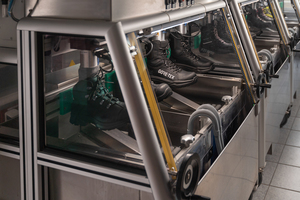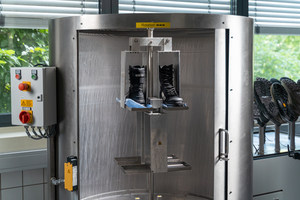
 |
Mark Sennett
Managing Editor |
 |
Kelly Rose
Editor |
| Home> | PPE | >Safety Footwear | >A step ahead |
A step ahead
16 August 2023
ACROSS THE global workwear sector, companies from the entire supply chain are becoming increasingly environmentally astute and adopting stewardship programmes. An urgency that runs from component/ingredient brands through to manufacturers and distributors is ensuring that the very highest standards are met, tested and extended. Here, Oli Willson describes the ways in which best practice is assessed and implemented.

NOW, MORE than ever, we can all play a part in protecting our planet and people by reducing our environmental footprint. The single most effective way to do this is to produce or procure better, more durable products which last longer. This saves money and the planet and there are many simple ways to work towards achieving these aims.
Trends in the design and construction of safety footwear are ever evolving, through innovations in materials and processes. Responsible companies, such as Gore, have been on a sustainability journey for decades. The use of scientifically based innovation to produce sustainable products is nothing new to such companies. It always requires, however, that any claims made regarding sustainability are fully backed up with science based evidence. The UK Government has created a green claims code.1 This asks businesses to prove their claims with robust, credible and up to date evidence. Proper, secure codes such as this and other accreditations ensures that environmental stewardship can be fully monitored.
The following labels prove environmentally responsibility has taken place during the manufacture of PPE footwear. These labels look at the manufacturing processes, chemistries used and the emissions from these processes. So, by understanding these it helps to ensure that what you buy is part of the solution, not part of the problem.
STANDARD 100 BY Oeko-Tex 2
This is an independent testing and certification system that tests for harmful substances in raw materials and finished products at all stages of production and demonstrates that a product is safe to wear. This is an industry standard and there is no other generally accepted equivalent label; since the early 1990s, Gore has held this standard. To achieve this STANDARD 100, companies are regularly required to commit to testing fabrics to ensure that they pose no health risk, according to requirements that exceed those laid down by statutory regulations.
Other labels, such as OEKO-TEX STeP and bluesign, detailed below, are two of many existing classifications that the check that responsible manufacturing is taking place.
OEKO-TEX STeP 3
This stands for Sustainable Textile & Leather Production and is a modular certification system for production facilities in the textile and leather industry. The goal of STeP is to implement environmentally friendly production processes in the long term, to improve health and safety and to promote socially responsible working conditions at production sites. The target groups for STeP certification are textile and leather manufacturers as well as brands and retailers.
bluesign 4
Since its creation in 2000, the bluesign mission, to pioneer sustainable industry manufacture and reduce environmental burden concerning the entire textile supply chain, has gone from strength to strength. This globally recognised system rigorously regulates the use of chemicals in products and strictly limits emission to water, air and land. Its stringent guidelines also cover the health and safety of employees and the protection of the environment along the entire supply chain. Gore and its supply partners have made significant investments to meet the high standard required by bluesign. Since 2010 Gore has certified all its facilities to conform to the bluesign system.
ISO14001 5
The globally recognised certification, ISO14001, is achieved by companies who measure and improve their environment management performance. This involves many elements including reviewing resource efficiencies and use of water and energy and lifecycle perspectives through sustainable product innovations.
Higg MSI Index 6
The Higg MSI Index was created by the Sustainable Apparel Coalition (SAC) and represents approximately 40% of the textile industry. Within the footwear sector it is used as a tool for measuring a product’s sustainability performance across the industry value chain. It does this by using industry average data to help understand the environmental impact of a product and gives directional guidance, which enables manufacturers to make more informed decisions in product design. It reviews, for example, the potential environmental impact of the outer fabric or leather, membranes and laminates by measuring 4 main elements: CO₂ equivalent emissions, water scarcity, fossil fuel depletion and eutrophication.
Life Cycle Assessment 7
This is a beginning to end assessment, which measures sustainability through 3 major life cycles; production, use and end of life.
Production considers raw materials, the impact of the manufacture and production of these into products and the transportation of finished products. The production phases for footwear have the largest environmental impact for CO₂ and water usage and therefore leading footwear manufacturers are making changes and driving innovation in order to facilitate impact reduction.
Use reviews the length of time footwear is worn and this has a huge impact on the environment. Simply put, durability and longevity offer the best way of achieving a sustainable approach and reduced environmental impact in the footwear sector. The longer footwear products are in use, the lower the environmental footprint will be. From a financial perspective, there is a greater return on investment if boots need replacing less often.
End of life solutions firstly considers if the product is able to be reused by another person to extend the product life. If the product has reached the end of life because it is not yet commercially viable to recycling technology for waterproof breathable footwear, then it should be disposed of in a responsible way according to local requirements.
Gore consistently looks for ways to produce items that reduce their overall environmental impact, for example we have set ambitious carbon reduction goals and we are investing to achieve these.8
Today, responsible footwear manufacturers focus especially on LCA and Higg indicators when designing and creating new products. Using a holistic approach ensures that environmental issues are accorded just as much value as the well-known qualities of comfort, safety and wearability in all Gore footwear products.
Innovation for sustainability
As a technology and science based company, Gore’s research and development division reviewed and considered water use within footwear manufacture. New EXTRAGUARD upper technology is a 3-layer upper material that combines the advantages of leather with those of textile upper materials. During its production, water usage is significantly reduced due to the different processes used, compared to those employed during traditional leather footwear manufacture. This based on Higg MSI calculations using industry average data.
In summary
It’s important to understand and review the latest environmental accreditations and certifications when considering sustainable PPE. Constant innovations and developments in protective footwear aim to enhance the wellbeing, safety and health of the workforce. Through using Life Cycle Assessment, the environmental impact can be reduced by long use. Purchasing products that are constructed and rigorously tested to be durable will protect the wearer for longer and will need replacing less often, saving money and will help play a part in a more sustainable approach to PPE procurement.
References
₁ https://greenclaims.campaign.gov.uk/
₂ www.oeko-tex.com/en/our-standards/oeko-tex-standard-100
₃ www.oeko-tex.com/en/our-standards/oeko-tex-step
₅ www.iso.org/files/live/sites/isoorg/files/store/en/PUB100371.pdf
₆ https://apparelcoalition.org/higg-product-tools/
₈ https://www.goretexprofessional.com/uk/sustainability/reduce-climate-change
Oli Willson is a professional footwear associate at GORE-TEX. For more information, visit www. goretexprofessional.com
- Flash protection
- New look delivers for postal staff
- Pioneering protection in electrified industries
- New sustainability framework adopted by GORE-TEX Professional
- New GORE PYRAD protective garments for everyday wear
- Power to protect
- Volcano workers kitted out
- An essential investment
- Weather the storm
- Flame-proof fabric



























